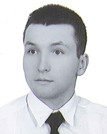| Leszek Frąś, PhD |

|
|
Doctoral thesis
| 2019-10-03 | Określenie dynamicznych właściwości materiałów magnetoreologicznych: badania doświadczalne i opis konstytuatywny lepkoplastycznej deformacji
|
Recent publications
| 1. |
Osial M., Nowicki M.♦, Klejman E.♦, Frąś L., Investigation of the well-dispersed magnetorheological oil-based suspension with superparamagnetic nanoparticles using modified split Hopkinson pressure bar,
Rheologica Acta, ISSN: 0035-4511, DOI: 10.1007/s00397-021-01318-9, Vol.1, pp.1-12, 2022 Abstract: Keywords:
| |||||||||||||
| 2. |
Frąś L.J., Dziekoński C., Dera W., Jarząbek D.M., Piezoelectric bimorph as a high-sensitivity viscosity resonant sensor to test the anisotropy of magnetorheological fluid,
REVIEW OF SCIENTIFIC INSTRUMENTS, ISSN: 0034-6748, DOI: 10.1063/1.5025123, Vol.89, No.10, pp.105111-1-7, 2018 Abstract:
| |||||||||||||
| 3. |
Frąś L.J., Pęcherski R.B., Modified split hopkinson pressure bar for investigations of dynamic behaviour of magnetorheological materials,
JOURNAL OF THEORETICAL AND APPLIED MECHANICS, ISSN: 1429-2955, DOI: 10.15632/jtam-pl.56.1.323, Vol.56, No.1, pp.323-328, 2018 Abstract: Keywords:
| |||||||||||||
| 4. | Kurnyta-Mazurek P.♦, Kurnyta A.♦, Pręgowska A., Kaźmierczak K.♦, Frąś L.J., Application concept of the active magnetic suspension technology in the aircraft engine, Aviation Advances & Maintenance, ISSN: 2543-9456, DOI: 10.2478/afit-2018-0006, Vol.41, No.1, pp.161-193, 2018 | |||||||||||||
| 5. |
Frąś T.♦, Frąś L.J., Faderl N.♦, Rubber and magnetorheological fluid applied as the interlayer in composite armours against high-velocity loadings,
DIAGNOSTYKA, ISSN: 1641-6414, Vol.18, No.3, pp.63-68, 2017 Abstract: Keywords:
| |||||||||||||
| 6. |
Frąś L.J., The Perzyna Viscoplastic Model in Dynamic Behaviour of Magnetorheological Fluid under High Strain Rates,
ENGINEERING TRANSACTIONS (ROZPRAWY INŻYNIERSKIE), ISSN: 0867-888X, Vol.63, No.2, pp.233-243, 2015 Abstract: Keywords:
|
Conference abstracts
| 1. | Frąś L.J., Dziekoński C., Dera W., Jarząbek D.M., The anisotrophy of viscosity of magnetorheological fluid., 8TH International Colloquium Micro-Tribology, 2017-09-11/09-13, Warszawa (PL), pp.1-2, 2017 | ||||||||||||||||||||||
| 2. |
Frąś L.J., Pęcherski R.B., Dynamic behaviour of magnethoreological materials,
MatCel'2017 & DynMatCel'2017, Cellular Materials: Structural Behaviour, Modelling and Characterisation, 2017-09-25/09-27, Aveiro (PT), pp.17-18, 2017 Abstract: Keywords:
| ||||||||||||||||||||||
| 3. | Dziekoński C., Dera W., Frąś L.J., Jarząbek D.M., Precise force sensors for micro and nanotensile tests., SolMech 2016, 40th Solid Mechanics Conference, 2016-08-29/09-02, Warszawa (PL), pp.1, 2016 | ||||||||||||||||||||||
| 4. |
Frąś L.J., Jarząbek D.M., Dziekoński C., Pęcherski R.B., Viscoplastic deformation of magnethoreological solids,
SolMech 2016, 40th Solid Mechanics Conference, 2016-08-29/09-02, Warszawa (PL), No.P244, pp.1-2, 2016 Abstract: Keywords:
| ||||||||||||||||||||||
| 5. |
Chrzanowska J., Denis P., Mościcki T., Hoffman J., Garbiec D.♦, Frąś L.J., Szymański Z., Characterization of tungsten boride layers deposited in pulsed laser ablation process,
SolMech 2016, 40th Solid Mechanics Conference, 2016-08-29/09-02, Warszawa (PL), No.P257, pp.1-2, 2016 Abstract: Keywords:
| ||||||||||||||||||||||
| 6. |
Frąś L.J., Konowrocki R., Pęcherski R.B., Niesprężyste deformacje materiałów magnetoreologicznych. Doświadczalna wizualizacja i model fizyczny,
OMIS'2015, XI Konferencja Odkształcalność Metali i Stopów, 2015-11-17/11-20, Łańcut (PL), pp.13-14, 2015 Abstract: Keywords:
| ||||||||||||||||||||||
| 7. |
Nowak M., Pęcherski R.B., Nowak Z., Frąś L.J., Numeryczna rekonstrukcja struktury pianek otwartokomórkowych z wykorzystaniem tomografii komuterowej,
OMIS'2015, XI Konferencja Odkształcalność Metali i Stopów, 2015-11-17/11-20, Łańcut (PL), pp.61-62, 2015 Abstract: Keywords:
| ||||||||||||||||||||||
| 8. |
Pęcherski R.B., Nowak M., Frąś L.J., Numerical simulations of auxetic metallic foam fabrication process,
PCM-CMM 2015, 3rd Polish Congress of Mechanics and 21st Computer Methods in Mechanics, 2015-09-08/09-11, Gdańsk (PL), pp.857-858, 2015 Abstract: Keywords:
| ||||||||||||||||||||||
| 9. |
Frąś L.J., Pęcherski R.B., Viscoplasticity of magnetorheological materials - theoretical description and experimental investigations,
PCM-CMM 2015, 3rd Polish Congress of Mechanics and 21st Computer Methods in Mechanics, 2015-09-08/09-11, Gdańsk (PL), pp.673-674, 2015 Abstract: Keywords:
|
Patents
|
Filing No./Date Filing Publication |
Autors Title Protection Area, Applicant Name |
Patent Number Date of Grant |
|
|---|---|---|---|
|
424702 2018-02-27 BUP 06/2020 2020-03-09 |
Frąś L.J., Jarząbek D.M., Pręgowska A., Chrzanowska-Giżyńska J. Measuring instrument for microscopic observation and measurement of deformation of materials in real time PL, Instytut Podstawowych Problemów Techniki PAN |
235566 WUP 13/2020 2020-09-07 |
|
|
421696 2017-05-24 BUP 25/2018 2018-12-03 |
Frąś L.J., Kołbuk-Konieczny D., Pręgowska A. Measuring holder for the split Hopkinson bar and method for measuring behaviour of a material, in which the split Hopkinson bar is used PL, Instytut Podstawowych Problemów Techniki PAN |
234657 WUP 03/2020 2020-03-31 |
|


















